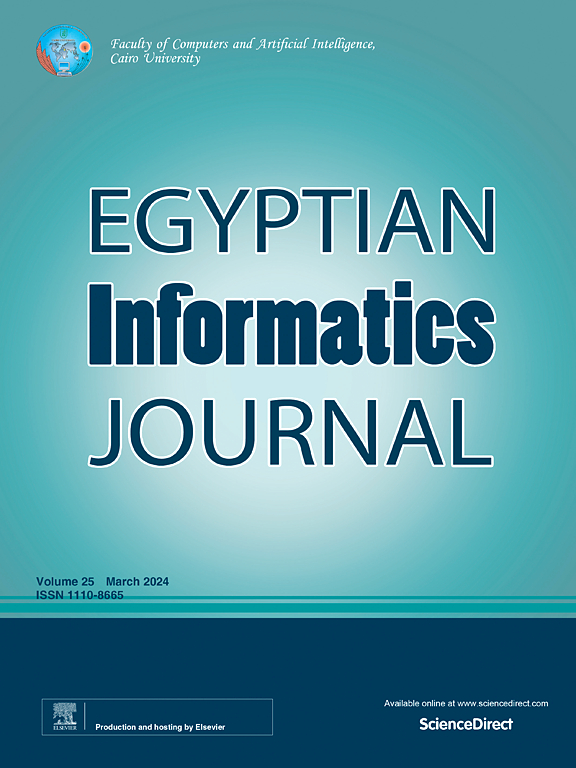Multi-strategy fusion binary SHO guided by Pearson correlation coefficient for feature selection with cancer gene expression data
IF 5
3区 计算机科学
Q1 COMPUTER SCIENCE, ARTIFICIAL INTELLIGENCE
引用次数: 0
Abstract
Cancer gene expression data is extensively utilized to address the challenges of cancer subtype diagnosis. However, this data is often characterized by high-dimensional, multi-text and multi-classification, which requires an effective feature selection (FS) method. A multi-strategy fusion binary sea-horse optimizer guided by Pearson correlation coefficient was proposed for FS with cancer gene expression data. For the multi-strategy fusion, the rest strategy is introduced in the sea-horse motor behavior stage. Subsequently, a search strategy based on symbiotic organisms of sea horses is designed for the predation stage. Finally, the elementary function dynamic weight strategy is proposed. Multi-strategy fusion enables the sea-horse optimizer (SHO) to perform dynamic exploitation and exploration in the early stage of iteration, expand the search scope initially, and narrow the search scope in the middle and later stages of the algorithm, so as to avoid the algorithm falling into the local optimal and increase the possibility of the algorithm jumping out of the local optimal, and avoid the blind search caused by elite influence. In the FS part, Pearson correlation coefficient guided strategy is proposed firstly to add or delete features. Then eight binary algorithms are derived from S-type and V-type transfer functions. The simulation experiment was divided into four parts. Firstly, the CEC-2022 test functions were used to test the performance of the multi-strategy fusion SHO, from which the best variant TanASSHO was selected, and then compared with other nine swarm intelligent optimization algorithms. Performance tests of various algorithm variants on 18 UCI datasets show that V1PTASSHO is the most effective binary version. Finally, V1PTASSHO was compared with other nine swarm intelligent optimization algorithms on 18 cancer gene expression datasets. The results demonstrate that V1PTASSHO effectively reduces feature subsets, improve classification accuracy and obtain lower fitness value. Friedman test and Wilcoxon rank sum test were used for statistical analysis to verify the effectiveness of the proposed algorithm.
基于Pearson相关系数的肿瘤基因表达特征选择多策略融合二元SHO
癌症基因表达数据被广泛用于解决癌症亚型诊断的挑战。然而,这些数据往往具有高维、多文本和多分类的特点,这就需要一种有效的特征选择(FS)方法。提出了一种以Pearson相关系数为指导的多策略融合二进制海马优化器。对于多策略融合,在海马运动行为阶段引入休息策略。随后,在捕食阶段设计了基于海马共生生物的搜索策略。最后,提出了初等函数动态权重策略。多策略融合使海马优化器(SHO)在迭代初期进行动态挖掘和探索,初期扩大搜索范围,在算法中后期缩小搜索范围,从而避免算法陷入局部最优,增加算法跳出局部最优的可能性,避免精英影响造成的盲目搜索。在FS部分,首先提出了Pearson相关系数引导策略来增加或删除特征。然后分别从s型和v型传递函数导出了8种二值化算法。仿真实验分为四个部分。首先,利用CEC-2022测试函数对多策略融合SHO算法进行性能测试,从中选出最佳的TanASSHO变体,并与其他9种群体智能优化算法进行比较。在18个UCI数据集上对各种算法变体的性能测试表明,V1PTASSHO是最有效的二进制版本。最后,在18个癌症基因表达数据集上比较了V1PTASSHO算法的其他9种群体智能优化算法。结果表明,V1PTASSHO有效地减少了特征子集,提高了分类精度,获得了较低的适应度值。采用Friedman检验和Wilcoxon秩和检验进行统计分析,验证算法的有效性。
本文章由计算机程序翻译,如有差异,请以英文原文为准。
求助全文
约1分钟内获得全文
求助全文
来源期刊

Egyptian Informatics Journal
Decision Sciences-Management Science and Operations Research
CiteScore
11.10
自引率
1.90%
发文量
59
审稿时长
110 days
期刊介绍:
The Egyptian Informatics Journal is published by the Faculty of Computers and Artificial Intelligence, Cairo University. This Journal provides a forum for the state-of-the-art research and development in the fields of computing, including computer sciences, information technologies, information systems, operations research and decision support. Innovative and not-previously-published work in subjects covered by the Journal is encouraged to be submitted, whether from academic, research or commercial sources.
 求助内容:
求助内容: 应助结果提醒方式:
应助结果提醒方式:


